Redbelly Tilapia, Coptodon zillii
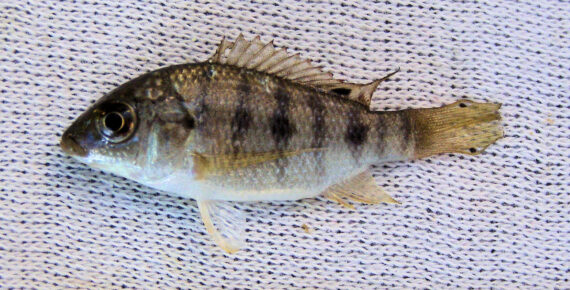 Redbelly Tilapia, Coptodon zillii, Juvenile. Fish collected with a net out of the San Javier Creek, San Javier, Baja California Sur, October 2024. Length: 4.3 cm (1.7 inches). Identification courtesy of Dr. John Lyons, Madison, Wisconsin.
Redbelly Tilapia, Coptodon zillii, Juvenile. Fish collected with a net out of the San Javier Creek, San Javier, Baja California Sur, October 2024. Length: 4.3 cm (1.7 inches). Identification courtesy of Dr. John Lyons, Madison, Wisconsin.
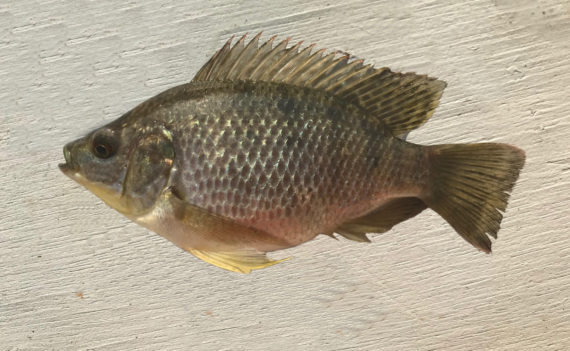
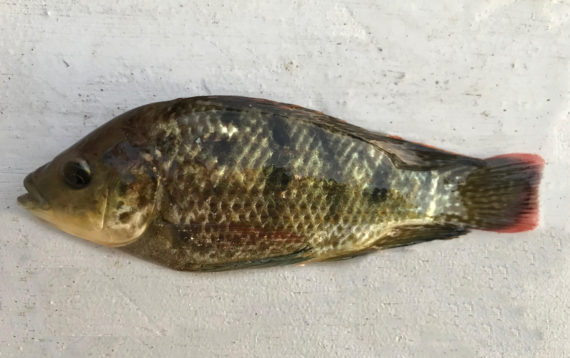
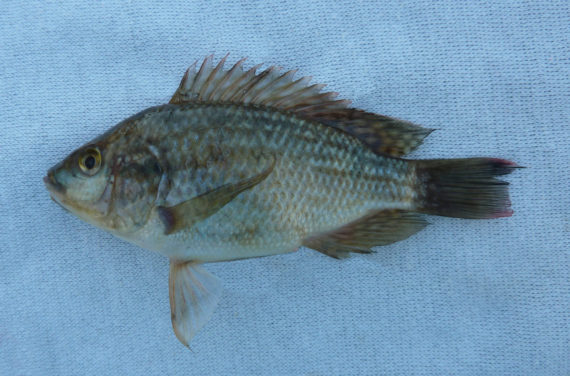 Redbelly Tilapia, Coptodon zillii. Three fish collected with a net out of the Rió de Santiago river basin in the Las Cuevas section of the East Cape of Baja California Sur, December 2017 and January 2018. Length: 10 cm (3.9 inches) to 13 cm (5.1 inches). Catch courtesy of Brad Murakami, Surrey, British Columbia, Canada. Identification courtesy of Dr. John Lyons, Madison, Wisconsin.
Redbelly Tilapia, Coptodon zillii. Three fish collected with a net out of the Rió de Santiago river basin in the Las Cuevas section of the East Cape of Baja California Sur, December 2017 and January 2018. Length: 10 cm (3.9 inches) to 13 cm (5.1 inches). Catch courtesy of Brad Murakami, Surrey, British Columbia, Canada. Identification courtesy of Dr. John Lyons, Madison, Wisconsin.
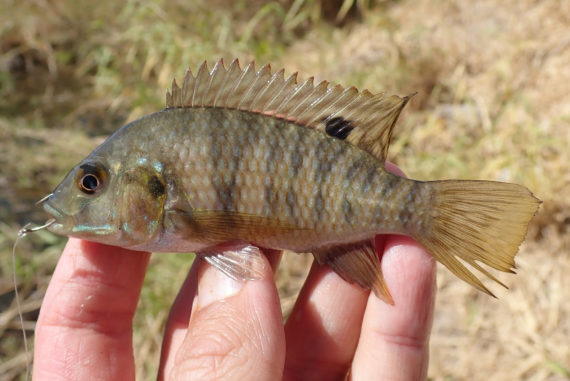 Redbelly Tilapia, Coptodon zillii. Fish caught out of an irrigation canal feeding the Salton Sea, California, August 2016. Length: 11.5 cm (4.5 inches). Catch, photograph and identification courtesy of Ben Cantrell, San Diego, California.
Redbelly Tilapia, Coptodon zillii. Fish caught out of an irrigation canal feeding the Salton Sea, California, August 2016. Length: 11.5 cm (4.5 inches). Catch, photograph and identification courtesy of Ben Cantrell, San Diego, California.
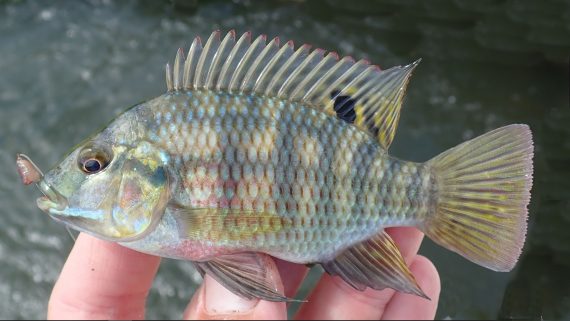 Redbelly Tilapia, Coptodon zillii. Fish caught out of Gila River, Phoenix, Arizona, August 2016. Length: 12.2 cm (4.8 inches). Catch, photograph and identification courtesy of Ben Cantrell, San Diego, California.
Redbelly Tilapia, Coptodon zillii. Fish caught out of Gila River, Phoenix, Arizona, August 2016. Length: 12.2 cm (4.8 inches). Catch, photograph and identification courtesy of Ben Cantrell, San Diego, California.
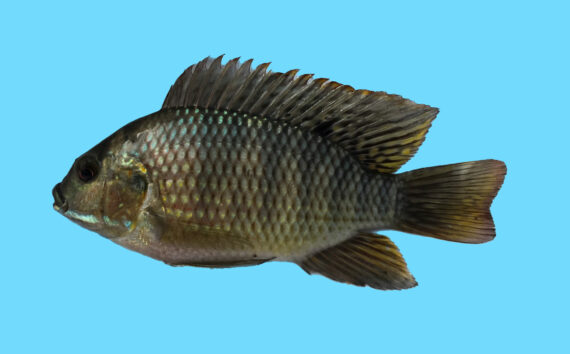 Redbelly Tilapia, Coptodon zillii. Fish caught from the Gila River, Phoenix, Arizona, August 2018. Length: 15 cm (5.9 inches). Catch, photograph and identification courtesy of Luke Ovgard, Klamath Falls, Oregon.
Redbelly Tilapia, Coptodon zillii. Fish caught from the Gila River, Phoenix, Arizona, August 2018. Length: 15 cm (5.9 inches). Catch, photograph and identification courtesy of Luke Ovgard, Klamath Falls, Oregon.
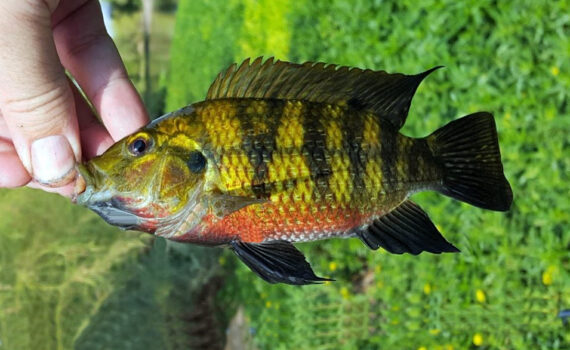 Redbelly Tilapia, Coptodon zillii, Breeding. Fish caught out of Salt River, Phoenix, Arizona, June 2017. Length: 18 cm (7.2 inches). Catch, photograph and identification courtesy of Chris Moore, Peoria, Arizona.
Redbelly Tilapia, Coptodon zillii, Breeding. Fish caught out of Salt River, Phoenix, Arizona, June 2017. Length: 18 cm (7.2 inches). Catch, photograph and identification courtesy of Chris Moore, Peoria, Arizona.
The Redbelly Tilapia, Coptodon zillii, is a member of the Cichlid and Tilapia or Cichlidae Family, and is known in Mexico as tilapia viente rojo. It is one of the three religiously significant fishes known as St. Peter’s Fish. Globally, there are thirty-one species in the genus Coptodon of which three are found in the freshwater systems of Mexico.
The Redbelly Tilapia has an elongated, deep, oval-shaped, and compressed body with a shape similar to that of an elongated bluegill. They are an olive color that are darker dorsally that transitions to light olive to yellow-brown on the sides, often with an iridescent blue sheen. Their chest if pink and their lips are bright green. They have 6 or 7 dark vertical bars that cross 2 horizontal stripes on the body and caudal peduncle. The fins are olive in color and covered with yellow spots; the anal and dorsal fins have a thin orange margin and the dorsal fin has a traditional “tilapia spot” towards the rear. Juvenile fish have and a uniformly colored yellow to gray caudal fin and as they mature the fin turns to gray with dots appearing with age. During spawning the throat and belly turn black and red and the bands on the side become very pronounced. They reach a maximum of 40 cm (16 inches) in length and 300 grams (0.67 lbs) in weight. Their anal fin has 3 spines and 8 to 10 rays; and, their dorsal fin has 13 to 16 spines and 10 to 14 rays. The have 8 to 11 lower gill rakers. They have life spans of up to 7 years.
The Redbelly Tilapia is primarily found in freshwater, at depths up to 6 m (20 feet), but they can also be found in brackish water as they are highly adaptable being able to tolerate varying water qualities, salinities and water temperatures. They are a diurnal species occasionally found in schools in shallow, vegetated areas with water temperatures between 11oC (52oF) and 36oC (97oF). They are also sensitive to cold water episodes and subject to massive kills in some areas where they have been introduced. They are considered to be potamodromous and thus will make seasonal migrations. Redbelly Tilapia are herbivorous consuming primarily algae, diatoms and aquatic macrophytes and small quantities of aquatic insects, crustaceans and fish eggs. Reproduction involves monogamous pairs and occurs in lake bottoms with pebbles or sand and abundant vegetation. Each female may deposit up to 6,000 very small eggs per spawn that are adhesive and attached to hard substrate and then are guarded by both parents. Their eggs hatch within 96 hours and the juveniles become free swimming in 4 to 6 days.
The Redbelly Tilapia is native to the freshwater tropical and sub-tropical systems of Africa and the Near East. Although established on a limited basis in the United States, identification has been problematic, and their range in Mexico has not been well documented.
The Redbelly Tilapia is often confused with the Redbreast Tilapia, Coptodon rendalli (caudal fin spotted dorsally, red or yellow ventrally) and the Spotted Tilapia, Coptodon mariae (lacks deep red ventral coloration, lateral bars extend on the dorsal fin, five or six square black blotches on the sides).
From a conservation perspective the Redbelly Tilapia have not been evaluated but should be considered to be of Least Concern with rapidly expanding widely distributed populations. They have been widely introduced globally for the control of aquatic plants, mosquitoes and chironomid midges, and as a food fish. Several countries report adverse ecological impact after introduction as the introduced Redbelly Tilapia can quickly become pests as they become strong competitors for the food and spawning sites of native fishes and can eat crops such as rice and numerous aquatic plants. They are raised by aquaculture and have also spread widely via escapes from fish farms and by aquarium releases. They are fished in some locations as a recreational sports fish.